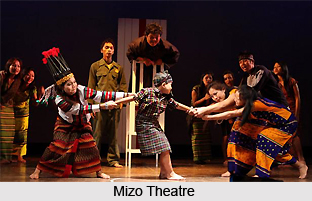Mizo theatre is a popular form of theatre in the north eastern part of India in the Indian state of Mizoram. It has ritual sacrifices annually to the gods and ceremonial dances celebrating triumphs in the hunt or against enemies, which enabled the heroes in their afterlife to go in Pialral (the Mizo paradise) ruled by the great distributor Pawla. After the Mizos were Christianized, missionaries kick-started the drama at the Christmas festivities of 1912 held in a not so big thatched roof theatre in Aizawl. There were various types of entertainment options and that included humorous dialogues, such as between an interpreter and an Englishman, a non-Christian and Christian, an old Englishman and old Muslim man.
 Development of Mizo Theatre
Development of Mizo Theatre
The most renowned and splendid item, Borsap lem, leh thu chhia nei tu tu leh Rasi lem chang be (`Superintendent`s Court Scene between Magistrate and Interpreter`), was allegedly the first proper play of Mizo theatre. The story was about a thief convicted of stealing a goat and bribing the interpreter. The conventions of Christmas theatricals continued every year and extended to the villages. The church too used them in their own services, to develop religions lessons, but withdrew the same, after the spiritual resurgence of 1919. The result that immediately followed as the appearance of secular drama also influenced by plays inspired from Puja by the Bengali community and army regiments. Educational professional, Ch. Pasena (1893-1961), wrote and also directed at a school in Aizawl, starting with Heroda chawimawina ("King Herod`s Glory", 1925), a biblical tragedy. He also dramatized two other short stories from the Holi Bible, Fapa tlanbo ("The Prodigal Son", 1927) and Khualbuka mi a ("Fool at the Inn", 1933), and composed three moralistic originals: Tinreng daih khawl ("Machine with a Brain", 1928) about a robot, Rasna khawmpui ("Animals Conference", 1929) against the evil of drinking, and Rorelna ("Court", 1933) on the wages of sin for a horrific boy. Apart from these, he assisted to produce The Merchant of Venice as Sailoka (1929), a grand success as the first Mizo Shakespearean drama.
In the year, 1934, Chawngzika directed Krista Palai ("Christ`s Ambassador"), which is evidently the initial script typed in Mizo language, for the Aijal Theatre Performers, who sold tickets for the first time in Mizoram. Lalkailuia, the son of a village chief, in 1935, based his plays on local themes, on folklores and acted the lead character, giving a dramatic feel to the famous love story of Tualvungi and Zawlpala. Few years after, Rev. Samuel Davies, from 1937 to 1951, trained in theatre from London, directed and introduced modern techniques and stage technology in Aizawl. For the Gospel golden jubilee in 1944, he gave a dramatic look and feel to the concept of emergence of Christianity as Thuhriltu ("The Herald"). He also jointly presented theatres along with Chawngzika - who adapted several biblical episodes for the stage, such as The Royal Robes (1948), Christmas Spirit (1949), and The Star of Christmas (1950). The musician and dramatist Lalzuithanga (1916-50) uniquely set a detective thriller - The Black Corner of Aijalin 1999 (1940), in the future, and began a tragedy titled The Horrible (1941) with the protagonist`s hanging, followed by his amazing manifestation as a ghost at the post-mortem. Lalzuithanga performed the heroes` as well as comic roles in his productions.
Post Independence Scene of Mizo Theatre
Nearly every Mizo village, by the end of World War II, possessed a home grown group of performers and actors. Slowly, the style of playwriting changed to represent, in more realistic way, the definition of life, like is works for most contemporary dramatists Lalhmuaka, the first woman playwright Khawlkungi, Lalthangfala Sailo, Laltluangliana Khiangte and Liansailova. After the printing of the first Mizo drama as late as 1962, over a hundred Mizo plays have been published since then.




















